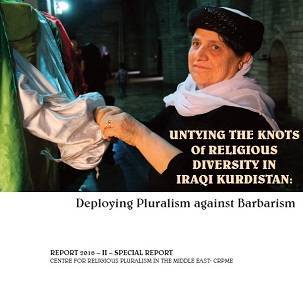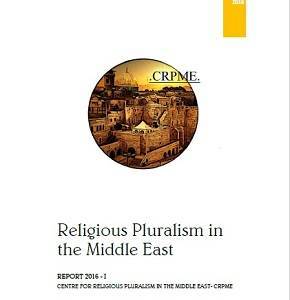The CRPME Reports were a feature of the Centre for Religious Pluralism in the Middle East (CRPME) and were introduced in June 2016, in an effort to provide an up-to-date analysis of developments related to religious pluralism and peaceful coexistence in the Middle East and the Maghreb. The work of CRPME was conducted by researchers of the Centre for Mediterranean, Middle East and Islamic Studies (CEMMIS).
 Executive Summary
Executive SummaryThe CRPME report is addressing main features and challenges regarding religious pluralism in the Middle East during the first half of 2018. The region of focus includes the countries of Syria, Iraq, Jordan, Turkey, Egypt, Israel, Saudi Arabia, Iran, Lebanon and the Maghreb region with an added emphasis on each country’s institutional framework. The aim of the report is, on the one hand, to pinpoint the challenges related to religious pluralism in the region. On the other hand, it strives to highlight positive state and community initiatives that promote religious co-existence and pluralism. The documentation work leading to the report reflects the research already published on the CRPME site, which is being constantly updated with the developments regarding the religious communities in the region. It is, thus, neither exhaustive nor discursive in covering all the relevant events but it focuses on the events that could reveal certain issues, trends, continuities and discontinuities.
 Executive Summary
Executive SummaryThe objective of this report is to highlight the main themes featured in the speeches of the participants of the 2nd Athens International Conference on “Religious and Cultural Pluralism and Peaceful Coexistence in the Middle East”, which took place from 30 to 31 October 2017. The conference aimed at overviewing main features and developments of religious pluralism in the Middle East in the past two years and proposed positive initiatives to promote religious coexistence and pluralism in the region.
 Executive Summary
Executive SummaryThe objective of the report is addressing the main developments concerning religious pluralism in the Middle East and highlighting the challenges that religious coexistence faces in the region. Building on the findings of the previous three CRPME reports, the analysis at hand focuses on featuring events and phenomena that have occurred in the past six months. The region covered includes Iraq and Syria, Egypt, Turkey and the Gulf Arab states. Additionally, the analysis of foreign actors’ humanitarian and diplomatic efforts vis-à-vis religious minorities in the Middle East is also part of this study. The documentation work carried out by the CRPME and published on the centre’s website serves as the basis for the report and is an ongoing endeavour, aiming at providing continuous updates on the state of religious pluralism in the Middle East. The findings presented, therefore, are not exhaustive, but highlight main trends and continuities.
 Executive Summary
Executive SummaryThe CRPME report is addressing main features and challenges regarding religious pluralism in the Middle East during the second half of 2016. The region of focus includes the countries of Syria, Jordan, Turkey, Egypt and Morocco. The aim of the report is, on the one hand, to pinpoint the challenges related to religious pluralism faces in the region. On the other hand, it strives to highlight positive state and community initiatives that promote religious co-existence and pluralism. The documentation work leading to the report reflects the research already published on the CRPME site, which is being constantly updated with the developments regarding the religious communities in the region. It is, thus, neither exhaustive nor discursive in covering all the relevant events but it focuses on the events that could reveal certain issues, trends, continuities and discontinuities.
 Executive Summary
Executive Summary§ Beside the threat of ISIS, Iraqi Kurdistan is facing deep political and economic crisis that have negative implications on religious pluralism, particularly, in the face of uncertainty after the liberation of Mosul and the broader region of Nineveh.
§ The work of KRG and, more specifically, the Ministry of Endowments and Religious Affairs, in conjunction with various initiatives from representatives of different communities in the Ministry are noteworthy. Law 5 of 2015 for the ‘Protection of the Components [Minorities] of Kurdistan’ is one of the fruits of their efforts. This promising, albeit limited, work shows the intention of KRG to create an environment of religious tolerance, which (will) distinguish it from the rest of Iraq and the wider region. This view, however, is not always shared by the politico-religious leadership and the members of the communities, who often portray these changes as merely cosmetic.
§ The religious and ethnic communities are alarmingly fragmented and are mired by inner-communal disagreements. The divide is not only across religious/doctrinal lines, but also political ones. A basic factor is the polarization driven by the conflict between KRG and the central government of Iraq.
 Executive Summary
Executive SummaryThe report is addressing main features and challenges of religious pluralism in the Middle East in the last six months. The region covered is mostly the Middle East including the Arabian Peninsula. Sometimes it may also include countries of the Maghreb, when there are developments of particular interest. The report is focusing on the great challenges religious pluralism faces in the region but, at the same time, it is highlighting positive state and community initiatives that promote religious co-existence and pluralism. The documentation work leading to the report reflects the research already posted in the Centre’s website, which is being constantly updated with the developments regarding the religious communities in the region. It is, thus, neither exhaustive nor discursive in covering all the relevant events but it focuses on the events that could reveal certain issues, trends, continuities and discontinuities.
The Centre for Mediterranean, Middle East & Islamic Studies posts a multitude of positions in the context of free academic debate. These do not necessarily reflect the positions of the CEMMIS. The use and reproduction of the multimedia material displayed in the CEMMIS website has non-profit character and serves academic and educational purposes, with full respect to copyright and intellectual property laws, and in accordance with the Greek Laws 2121/1993 and 2557/1997.

